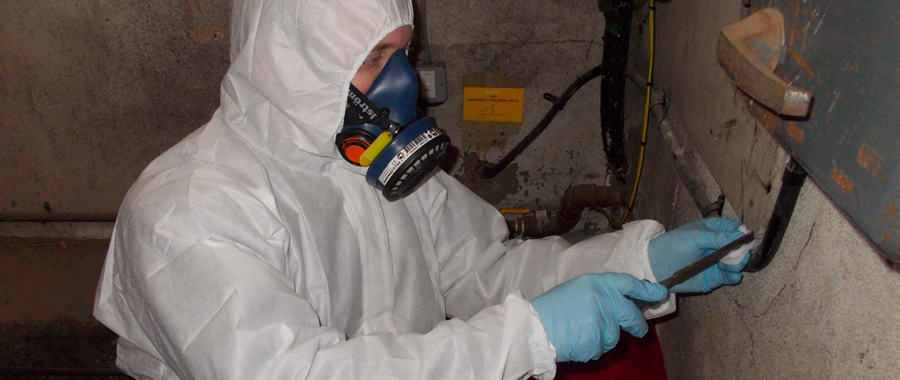Managing Asbestos In Public Sector Buildings
The health and safety responsibility and management of facilities in public sector buildings can fall across a number of varying roles. With more than 500,000 public buildings still estimated to contain asbestos today, the requirement to manage asbestos-containing materials (ACMs) remains a big responsibility for public sector managers.
Increasingly, awareness campaigns are being championed by Institution of Occupational Safety and Health (IOSH) and Health and Safety Executive (HSE) around the presence and management of asbestos. The UK Asbestos Training Association (UKATA) has also urged all public sector employees to be more aware of asbestos in public buildings to prevent putting users and workers of the buildings at risk of asbestos exposure.
A legacy problem
The dangers of asbestos were not officially recognised until the 1970s but, despite this, it was still used throughout the UK until the asbestos ban in 1999. As such, buildings that were constructed before 2000 are highly likely to contain asbestos, including aging public buildings like hospitals, schools, libraries, museums and town halls.
With this year marking 20 years since the ban of asbestos, the legacy problem of asbestos still needs to be addressed. Awareness and training is needed to combat the risk of exposure and ensure compliance and safety for those using and working in the facilities, buildings and areas that still contain ACMs.
Its versatility and extensive properties means asbestos can be found in varying forms, such as:
- asbestos lagging used as thermal insulation on pipes and boilers
- sprayed asbestos used for thermal insulation, fire protection, noise insulation
- asbestos-insulating board (AIB) used for fire protection, thermal insulation, partitioning, ducts and some ceiling tiles
- floor tiles
- cement roofing and guttering
- textured coatings
As well as building structures themselves, asbestos can also be found in boiler rooms, central heating systems, pipe lagging, portable heaters, electrical switch insulators, and radiator casings. Asbestos in common items means that asbestos awareness is crucial to protecting health. Because of its widespread use, thousands of public buildings are likely homes to what UKATA have termed the ‘ticking time-bomb’.
Asbestos in schools
The Government and various action groups are taking active steps forward to raise awareness of the dangers of asbestos in school properties, following a National Union of Teachers (NUT) survey in March 2017 where nearly 50% of respondents had not been told whether their school is one of the 86% which contains asbestos.
For caretakers in schools who are conducting small repairs or bigger maintenance tasks, not having access to the known location of asbestos within the school can cause incidents that release asbestos fibres into the air. The importance of awareness, knowledge and training cannot be stressed enough to mitigate any risk to staff, students and workers within schools.
Asbestos in hospitals
More recently, the government has been urged to conduct an audit to discover the extent of asbestos presence within the NHS hospital trusts in addition to a BBC survey discovering that nine out of 10 NHS trusts have asbestos in their hospitals.
The presence of asbestos in hospitals, and other public buildings, is not surprising given their age and it should not in itself be a significant cause for concern. Greater emphasis should be given to the control measures that are in place at these hospitals and how the materials are being safely managed. The encouraging element of the BBC article is that the 198 hospitals are aware of the asbestos in their buildings, indicating that they are meeting their requirements to have a record of the asbestos location in the buildings they control. Attention must be placed, though, upon the buildings where there is uncertainty if asbestos is present or not – which is a legal requirement.
Mitigating risk and implementing control measures
If you own, occupy or manage premises which may contain asbestos, you have a legal duty to manage the risk – under Regulation 4 of the Control of Asbestos Regulations 2012. Known as the ‘Duty to Manage’, the legislation applies to all non-domestic buildings and includes commercial, public and industrial premises, which should take the following steps to manage asbestos:
- Undertake an inspection and maintain a register of asbestos-containing materials (ACMs) in the building
- Assess the risks associated with ACMs in the premises
- Devise a plan for managing asbestos in the hospital, school or other building
- Make sure staff, visitors and contractors know the risks and precautions they need to take
- Keep the management of asbestos in the public building under review
Download the 5 compliant steps to managing asbestos - infographic
Within the guidance, duty holders are defined as the people responsible for maintenance and repair and/or access to the building. Understanding that responsibility is fundamental to effective asbestos control; the duty holder of the building must locate and assess the risk posed by asbestos containing materials as well as develop a risk management plan. For community schools, this is usually the local authority and for academies it may be the school governors.
Where any duty holder is unsure how to approach their duty to manage, an asbestos consultancy can support in ensuring full compliance with regulations and ensuring safety. Additionally, asbestos training can support individual employees in their role for ongoing awareness and equipping staff with the required knowledge to handle and manage asbestos.
Logistical challenges
Health and safety is the first and foremost priority for anyone responsible for the maintenance of a public building – and yet the headlines of media are more often featuring stories of inadequate management and control of asbestos, leading to occurrences of asbestos exposure. In fact, the BBC found “352 claims were made against health trusts between January 2013 and December 2017 by people who had developed asbestos-related diseases in NHS buildings”.
While funding cuts are stretching public sector resource, asbestos management should remain a fundamental priority for trusts, hospitals and schools to mitigate the risk of asbestos-related diseases. With hospital trusts paying out more than £16.4million in compensation as a result of poorly managed asbestos within their buildings, management of these materials should be considered an effective step to saving costs, meeting legal requirements and safeguarding public health.
There is often a misconception that the presence of asbestos requires removal - but this is not necessarily the case. If sealed, undisturbed and in good condition, the asbestos present is not considered a health hazard as the fibres will remain encapsulated. Removal is an option for items in bad condition or items liable to damage/degradation. Refurbishment or maintenance works, for example, can all pose a risk of disturbing the asbestos, which is why knowing the location of asbestos containing materials is fundamental to long-term safe management.
Of course, undertaking asbestos removal works within a hospital environment is extremely challenging and costly. With pressure on bed space and funding, hospitals will struggle to justify the proactive removal of asbestos containing materials, which can be safely managed in situ with the correct processes and procedures.
Deciding which asbestos survey is needed
Caretakers, facilities managers or subcontractors undertaking small repair jobs within a school or hospital must have access to asbestos records and appropriate role-responsibility training.
A management survey is non-destructive, and should be carried out to provide the necessary information for the property’s asbestos register. All accessible surface materials will be assessed. If accessible, this could also include areas such as ceiling voids and risers, which could be subject to maintenance activity.
Before any works is undertaken for demolition, refurbishment or maintenance purposes (that will disturb the fabric of the building), a refurbishment or demolition survey should be carried out. Both surveys involve intrusive inspection of normally inaccessible areas with the aim of locating 'hidden' asbestos containing materials, which could be disturbed by the planned project. For example, if there are refurbishment plans or installation works for a new service, fire alarm or CCTV (that will disturb the buildings structure) then an asbestos refurbishment survey is required.
Asbestos surveys in public sector buildings may pose logistical challenges, but not fully understanding the location of asbestos can lead to accidental exposure to asbestos fibres, possibly causing significant health risks and hefty financial fines. Appointing a trained specialist for surveying can support the duty holder of any public building in meeting that requirement.
Understanding the sensitivity of public sector buildings is crucial to safe and effective management, which is where SOCOTEC’s extensive experience in this area may be of benefit to building managers.
Get in touch with us to find out more about how SOCOTEC can support you in your asbestos management.






Add new comment